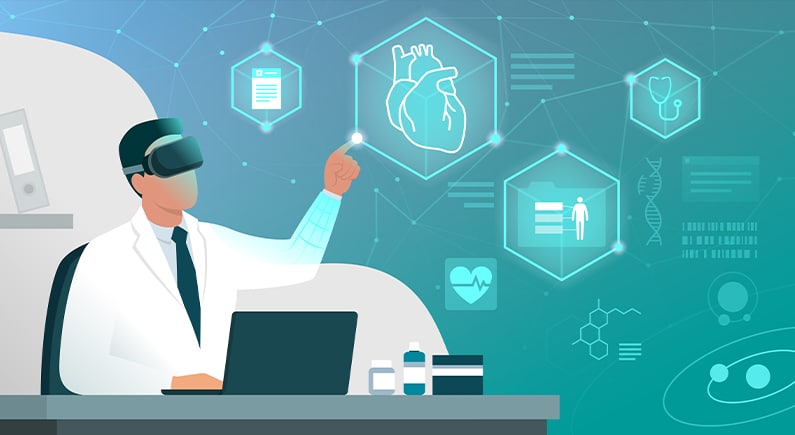
Michael Joe Cini
25th May 2022
How the Metaverse could transform the healthcare system
In 1981, Vernor Vinge, a retired professor of mathematics and science fiction author, published the novel “True Names” In the book, he creatively conceived a virtual world that enters and obtains sensory experience through a brain-computer interface. In 1992, Neal Stephenson in his novel “Snow Crash” coined the term “Metaverse” by describing imaginary characters exploring an internet world parallel to the real world using digital avatars of themselves for perception and interaction. Those were the earliest appearance of the metaverse. However, it became a widely discussed concept in 2021; in October of the same year, Mark Zuckerberg, the owner of Facebook, announced that Facebook had changed its name to “Meta” to align the company with its focus on new computing technologies and the metaverse.
The rise of the metaverse has brought infinite possibilities and shown its potential to revolutionize sectors and occupations, such as entertainment, gaming, socializing, work, and commerce. The healthcare system is not left out; the metaverse has the potential to upgrade all aspects of healthcare, from virtual wellness to pain management to complicated surgical procedures. This new concept is expected to contribute to improving comprehensive healthcare as well as diagnosing, preventing, and treating diseases.
Understanding The Metaverse
There’s still a bit of confusion when it comes to what the metaverse really stands for. While Zuckerberg sees it as a universe in which people will be able to do almost anything they can imagine, Microsoft defined it as a persistent digital world that is inhabited by digital twins of people, places, and things. A more comprehensive description considers metaverse as the next-generation mobile computing platform which will take advantage of artificial intelligence (AI), augmented reality (AR), virtual reality (VR), and ever-increasing connectivity to create online environments that are more immersive, experiential, and interactive than what currently exists.
It involves the confluence of three major technological trends: Telepresence (e.g Telemedicine), Blockchain, and Digital twinning. They all have the potential to impact healthcare individually, however, together, they could create absolutely new channels for providing care that have the potential to lower costs and vastly improve patient outcomes.
The Metaverse in Medicine
The metaverse in medicine is defined as the medical Internet of Things (MIoT) facilitated using AR and VR glasses. Already, the impact of the metaverse in medicine is transformational, with demonstrated use of VR headsets for pain relief, and treating phobias and anxiety disorders. However, the metaverse concept is greater than this; it allows an individual to meet their therapist via the device as a digital avatar; have their consultation held in a virtual office, and can even visit a virtual pharmacy to order their prescription medicine. Asides from that, they can meet up with other patients in virtual communities to share, in their avatar form, their treatment progress; and discuss new developments relevant to their ailments.
Telemedicine
The metaverse will enable improvement and expansion of the traditional telemedicine services, making it possible for healthcare providers to effectively virtually examine patients and make the appropriate diagnosis of certain conditions.
In the metaverse, patients aren’t limited to healthcare professionals in their geographic location. This is quite helpful as everyone, especially in areas of the world where there is a shortage of medical professionals or where people have trouble accessing care, has access to health consultation. The metaverse eliminates geographic barriers to getting care.
Mental Health
VR has demonstrated effectiveness in the management of phobias and anxiety disorders. Likewise, the metaverse could potentially revolutionize mental health treatment. The serene, immersive virtual experience provided by the metaverse could be helpful in the treatment of conditions like psychosis, delusion, hallucinations, eating disorders, and other mental disorders.
Surgery and Training
In the surgical field, AR, VR, and AI are already being used. AI is used in minimally invasive surgery while VR is applicable in relieving post-surgical pain.
AR and VR simulations in the metaverse are being used in medical and surgical training to help both students and residents hone their crafts and face various technical challenges and complications. Additionally, digital twins in the metaverse could be used by healthcare providers to predict how patients will react to medications, recover from illness, or rehabilitate after surgery.
About Med-Tech World:
Being led by physicians we have a deeper understanding of how things in the healthcare industry work. We know healthcare is not like any other industry and as a result provide the expertise that others do not. Have an exhibition booth of your own, throw a specific side event, or else just tell us what you want to get out of Med-Tech and we’ll have a dedicated team drum up the most relevant opportunities for you.






